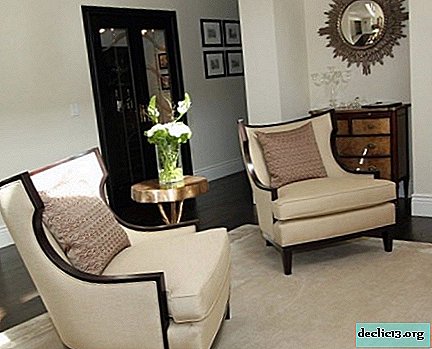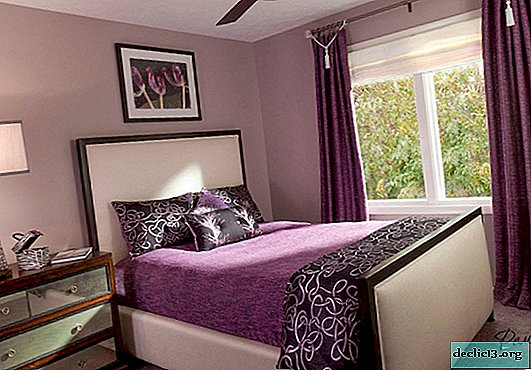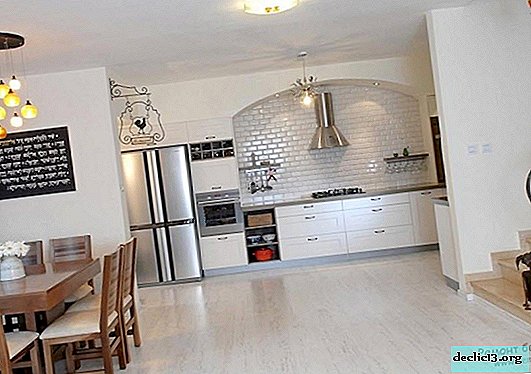Armchairs for a home interior: we sit well
One of the simplest pleasures in life, which is especially appreciated at the end of a day filled with bustle, a huge number of completed and unfinished business, contacts useful and useless, is to sit down, close your eyes and relax for a while in a limited individual space. Sofa? Designed for collective use, any of the households can get hooked at any moment and destroy the sweet immersion in a state of peace and bliss. Another thing is a chair, the most suitable piece of furniture that can organize a cozy sitting area in any of the rooms - a living room, a bedroom, an office, a nursery, on an open terrace.
 Cozy soft chairs in the living room by the fireplace. Slightly reclined back, turning into armrests, deep landing, allow you to sit in a comfortable posture for relaxation and pleasant conversation
Cozy soft chairs in the living room by the fireplace. Slightly reclined back, turning into armrests, deep landing, allow you to sit in a comfortable posture for relaxation and pleasant conversation




1. Historical background
An armchair as a seat designed for one person, equipped with a back and armrests is an ancient invention. To verify this, just look at the images of the pharaohs from the Egyptian pyramids. Ancient Egyptian masters were supposed to create monumental works (up to mandatory ergonomics there were still many millennia ahead!), Where the main task was to impress, to suppress with the grandeur of details made of expensive wood, ivory, carved jewelry, precious inlays (elementary conveniences of an unfortunate pharaoh who had to spend a working day on a luxurious throne, were not taken into account). Therefore, having ordered an absolutely retro-old stylish armchair to decorate a modern interior, you can only use it as an element of decor (although this is also a function!).
Turning over the illustrated pages of history, we are convinced that in the era of ancient Greece and Rome, a small step towards ergonomics was made in the form of animal skins, softening the stiffness of the seat.
Viking homes, medieval castles were furnished with heavy wooden furniture, among which the chair was the prerogative of the power elite (as a throne for the ruler).
The real birth of the chair as a genre of furniture design dates back to the times of the brilliant courtyards of French kings and aristocrats. The wooden frame got an upholstery from expensive fabric (Chinese silk, velvet, tapestry), for softness, pillows with down fillers began to be used. The back, armrests and legs began to look more like objects of applied art. Medieval craft workshops competed with each other in the production of luxurious furnishings, and modern European furniture factories attribute the appearance of their traditions to free associations of cabinetmakers.
The twentieth century, especially its middle, can be safely called the "golden age" of industrial design, when a great many unique and magnificent designs were proposed that have not lost their relevance at the present time, as evidenced by numerous remakes of furnishings and the re-entry into fashion of samples from the best authors.
The concept of ergonomics took shape as a direction of industrial design in the middle of the last century and became an integral standard in the design of furniture, including armchairs. The essence of the ergonomic approach can be expressed briefly - the conformity of any item of furniture to the anatomical features of the human body to create maximum comfort (during work and rest) and maintain health. At the same time, aesthetic appeal is combined with functionality and rationalism.
Today, across all continents - European, American and Asian - a whole galaxy of talented young designers has appeared, destroying traditions and stereotypes and creating a new aesthetics of furniture design of the future. The everyday life includes modular transforming chairs, multifunctional chairs with built-in shelves, tables, lamps and other accessories.

Rattan wicker chairs used by designer Harold Leidner
for his Whimsical Rooftop Garden project - a magnificent bizarre garden,
rooftop high-rise building in Dallas (USA)
Upholstery materials are natural wear-resistant fabrics - New Zealand wool, cashmere, cotton, linen, leather Wicker rattan chairs, synthetics, as well as literally knitted manually.
A popular technique of applying a pattern to fabrics - print - has found its application in the design of armchairs, giving the image completeness and personality.
 The print made it possible to apply a magnificent ethnic pattern to the fabric, harmoniously complementing the interior with furnishings and decor elements in the Japanese style
The print made it possible to apply a magnificent ethnic pattern to the fabric, harmoniously complementing the interior with furnishings and decor elements in the Japanese style


It is generally accepted that to create a perfect interior, it is enough to use two factors - free space and the right combination of colors. The colors of the upholstery allow you to create bright accents or contrasts with other objects of decor.
 Blue upholstery in Danish Art Nouveau style forms a color accent in the calm pastel colors of the minimalist living room
Blue upholstery in Danish Art Nouveau style forms a color accent in the calm pastel colors of the minimalist living room



The style classification coincides with the main artistic trends - classical (baroque, empire, rococo), constructivism, rustic, provence, hi-tech, with the characteristic features inherent in each of them. In fashion, stylization for a certain image.
 Baroque style styling (neo-baroque) - large dimensions, luxurious upholstery fabric, carved legs made of expensive wood, arched outward and rounded armrests, accessories - sofa cushions with designer covers
Baroque style styling (neo-baroque) - large dimensions, luxurious upholstery fabric, carved legs made of expensive wood, arched outward and rounded armrests, accessories - sofa cushions with designer covers




Wooden armchairs in rustic style (translated as simple, rough)made, as a rule, of natural wood.Deliberately simple forms are compensated for by careful processing.innovative and ecological varnishes giving the furniture a picturesque look.Rustic style is another name for the direction.Upholstered large armchair with fabric upholstery stylized as homespun clothfor those who don't like hard seats





Use in the interior of chairs of various designs,the style, color scheme of the upholstery is characteristic of the direction of fusion.This is a kind of freestyle in the way of interior decoration -the more heterogeneous things, the more colorful the “mixture”.But this creates a paradoxical atmosphere of harmony and charm
There is a classification of armchairs associated with design features: armchair-bathtub, winged armchair, armchair-bed, etc.

Chair-bath has an original design:
low back smoothly into the armrests, legs hidden deep under the seat,
textile or leather upholstery can be used

A classic winged chair rests on twisted front legs,
has a high back and bent armrests.
Buttons-buttons in a fabric shell, deeply fixed on the surface of the upholstery,
serve as decorative elements
2. Designer chairs
A special group of furniture was called designer furniture and reflects the spirit of the time through the refraction of individual perception and self-expression of an individual designer. Today this direction is the most demanded and interesting. The names of the best developers of the last century are coming back, who generated so many interesting ideas and designs that anticipated many of the trends of the present century, and which are enough for many generations of interior designers.
For example, in 1968, the famous Finnish designer Eero Aarnio created a chair made of transparent acrylic, which hung from the ceiling, since, according to the designer, any leg would damage the impression of lightness and airiness of the “soap bubble”. The model turned over the idea of how the chair should look.
... I wanted light to penetrate into the inside of the ball from all sides
Eero Aarnio Finnish designer born in 1932

Alvar Aalto created magnificent ergonomic chairs. Of particular interest are designs made from Master’s favorite material - bent plywood.
You can and must soar, but still with at least one foot or thumb to stand on the ground.
Alwar AaltoAlwar Hugo Henrik Aalto (1898-1976), Finnish architect, furniture designer, sculptor, painter
Upholstery - a print with a zebra pattern.
Chairs by Alvar Aalto used by designer Kristen Rivoli
for decorating the living room in modern style
Schools of French and Danish design experimented with traditional and innovative styles, techniques and materials in creating furniture. The two directions did not compete, but complemented each other.
What cannot be manufactured will not be designed
Jean ProuvetJean Prouvet (1901-1984) is a French architect and designer. One of the most talented designers of the XX century.Hans Wegner Hans Jorgensen Wegner (1914-2007), a world-famous Danish designer, has developed more than 500 models of chairs and armchairs. His works are distinguished by organic functionality. Designers from different countries include iconic designs in the design of modern interiors.
Modern interior with designer armchairs by Jean Prouvet (1951 model)
and Hans Wegner (The Papa Bear Chair he created in 1951
exists in many modifications and remakes
Milo Boman extolled the positive benefits of good design to human life. His designs were far-sighted and unusual, but unpretentious and affordable.
A structured environment should offer significant social and emotional benefits; it cannot just look good. When discussing the importance of the environment, we primarily discuss the quality and importance of human life
Cute boman Milo Boman (1923-2003) - famous American designer,
Chair with an ottoman from Milo Boman with a stainless steel frame,
executed in the color of kiwi, complements the furniture of the home cabinet in the Art Nouveau style.
The product was developed in 1987 and named Boldido
Charles and Ray Eames made a huge contribution to the development of industrial design of the twentieth century. Their molded plastic armchairs have become iconic examples of the industrial style and are represented in permanent exhibitions of European and American museums of modern art.
Design is a plan for grouping elements to achieve a specific goal.
Charles and Ray Eames Charles Eames (1907-1978) Ray Eames (1912-1988) - the family and creative union of American designers
Interior Designer Robert Caner
used an Eames molded plastic chair,
fiberglass reinforced (developed in 1948)
organically fitting it into the modern interior of San Marino Island House
3. Harmless advice
When purchasing an armchair, it should be remembered that the most comfortable piece of furniture should correspond to the general concept of the space being designed or be a contrasting accent to it. The main thing is to prevent congestion, restrictions on freedom of movement. Another question that should be answered is what role the chair will play in the interior: functional (that is, used for its intended purpose) or decorative (then everything can’t be sitting in a museum, just admire and admire from afar).
Factors influencing the choice of "pet":
- comfort (ergonomics),
- appearance,
- durability,
- mobility,
- resistance to pollution and negative environmental influences,
- ease of maintenance.

















